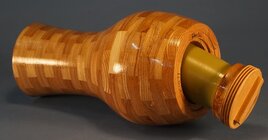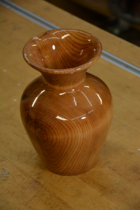Water vapor, from this website-
Water vapour diffusion

www.ampack.biz
"Water vapour molecule has the size of only one ten-millionth of a millimetre (0.0000001 mm); therefore it is totally invisible to us. This also explains why substances that are absolutely impervious to water are relatively easily penetrated by water vapour."
--------
When it evaporates, or heated to its boiling point, the smallest liquid water "particle" expands 1600x the size of the liquid into a vapor (gas) form, those water molecules are now really spread out. And although a "barrier" may stop a liquid, it may not stop a vapor.
So, the question for epoxy products is this- What is the *water vapor* permeability (perm) rating of the cured epoxy film? You'd need to visit the epoxy manufacturer for that info.
Water vapor, not liquid water. A coating of just about any epoxy will stop liquid water, but if the environment (inside of the vase) has a humidity level of 100%, could water vapor get through the epoxy (if the proper epoxy composition, mixing, and application is not achieved) and into the wood? Maybe. Well, practically speaking, since the top of the vase is open to the vase's outside environment, water vapor, which wants to move from a wet area to a dry area with the least resistance of getting there, likely would not penetrate the epoxy, it'll just travel out of the vase to the dryer enviroment outside the vase. Now, make a sealed lid for that epoxy coated vase, put water inside, and watch what happens. There is a chance that if the epoxy is not water vapor impermeable, given time you will lose the water from the enclosed vessel by way of the evaporated water (vapor) escaping through the epoxy and wood. (Science is fun!)
Because something is waterproof, it does not mean that barrier is water vapor-proof. Go to the hardware store and buy heavy 6-mil polyethylene plastic sheet (typical construction plastic), it has a water vapor permiability rating of 0.06, meaning evaporated water can escape right through the plastic... very, very slowly.
West Systems knows epoxy for water environments. I'd trust it to line a wood vase more than Ace Hardware-branded 5-minute epoxy in squeeze tubes.
(As a building inspector, I get to deal with this perm stuff regularly. Just earlier today, actually, in the HVAC realm with flexible insulated air ducts and their perm ratings.)



